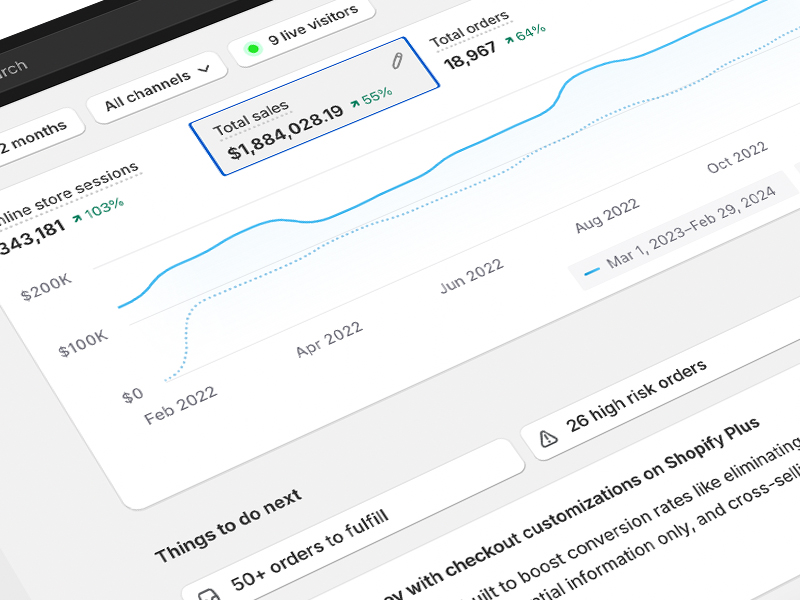Specialized marketing services with Lakeside Marketing can dramatically shorten the time to ROI and foster sustainable growth for your healthcare practice.
How fast can you recoup your development and marketing investments?
Maximizing the Potential of eCommerce for Your Practice
Healthcare practitioners have a golden opportunity to enhance their traditional brick-and-mortar clinics with lucrative ecommerce platforms. Integrating a dropshipping business into your existing practice can not only diversify your revenue streams but also extend your reach and impact. However, to truly capitalize on this integration, understanding and maximizing your Return on Investment (ROI) is crucial. Let’s explore how specialized marketing services can dramatically shorten the time to ROI and foster sustainable growth for your healthcare practice.
What You’ll Learn
- Critical Factors Influencing Your ROI
- Assessing Product-Market Fit
- Enhancing ROI
- ROI Calculator for Natural Healthcare Practitioners

Integrating ecommerce solutions into your brick and mortar practice will allow you to sell more and offer better services to your existing customer base.
What have you done so far? It impacts your ROI!
Let’s be honest, your ROI potential is about the work you have already done before you start a secondary ecommerce revenue stream. The more work you put into your brand, the better your ROI will be. ROI in digital marketing for healthcare ecommerce is a measure of the profitability of your online efforts. It’s not just about sales; it’s about creating a cohesive strategy and building a brand that aligns with your practice’s values and meets your patients’ needs. With the right approach, your investment in ecommerce can yield substantial returns, both financially and in patient satisfaction.
1. Current Email List Size and Quality – Do you have an engaged email list? Targeted, educational email campaigns can nurture leads, turning inquiries into loyal customers, thereby accelerating your ROI. We find that many practitioners do not know that they already have an email list hidden in their inbox, payment systems and practice management software, learn more here.
2. Current Social Media Presence – Are you posting regularly to Facebook, Instagram, TikTok, Google Business, or YouTube? An active social media profile can significantly expand your reach. Consistent, quality content that educates and engages your audience can transform your social media channels into powerful tools for customer acquisition and retention.
3. Networking and Collaboration – Are you networking with your community? Leveraging your professional network, including collaborations with influencers in the natural healthcare sector, can enhance your market presence and drive traffic to your ecommerce platform.
4. Online Reputation – Do you have reviews on Google, Yelp or Healthgrades? A positive online reputation, bolstered by patient reviews and testimonials, can be a major trust signal for new customers, encouraging them to choose your online offerings.
5. Brand Strength – Do you have a strong local brand that drives referrals? A strong, trustworthy brand is invaluable. It not only attracts initial customers but also fosters referrals and repeat business, contributing significantly to a quicker and higher ROI.
Strategizing for Optimal ROI
Calculating your ROI involves subtracting the marketing investment from the gain, then dividing by the investment cost, and finally multiplying by 100 to get a percentage. But beyond the math, understanding where your efforts yield the best returns is vital. Tracking customer behavior, engagement rates, and direct sales from marketing campaigns can provide insights into what’s working and what’s not.
Are You Moving in the Right Direction?
To ensure that your ecommerce venture aligns well with your existing healthcare practice and meets the market demand, it’s essential to gather both qualitative and quantitative feedback. This dual approach allows you to measure not only the subjective experience and satisfaction of your customers but also the numerical success of your marketing efforts.
Understanding the Customer Experience
It takes time to build a customer list. In the beginning, you will be investing into building a foundation of trust. While sales numbers are important, the story behind the data is often told through qualitative feedback, which provides insights into the customer’s thoughts, feelings, and preferences. Methods to gather this type of feedback include:
- Patient Interviews – One-on-one conversations with patients who are receiving your newsletters, reading blog posts, and engaging on social media can uncover detailed insights into their experiences, motivations, and any obstacles they encountered.
- Customer Reviews and Testimonials – Feedback on your products and services can offer honest reflections on their quality, usability, and impact new customer trust.
- Customer Support Experience – Chat, email and social media comments should be gauged to better understand if you are on the right path.
Qualitative feedback helps in understanding the ‘why’ behind customer behaviors, offering a deeper look into how well your products and services fulfill their needs and expectations. This feedback can be invaluable in refining your marketing approach and ensuring your ecommerce platform effectively supports your brick-and-mortar practice.
The Numbers That Measure Success
Quantitative measures provide concrete data that can help you track progress, identify trends, and make informed decisions. Key metrics to consider include:
- New Customers – The number of new users registering on your ecommerce platform can indicate the market’s interest in your products or services.
- Social and Email Engagement Rates – How often and deeply users interact with your content, such as website visits, time spent on pages, and social media interactions, can reveal how compelling and relevant your offerings are.
- eCommerce Conversion Rates – The percentage of visitors who make a purchase against the total number of visitors is a crucial indicator of how effectively your marketing translates into sales.
Monitoring these metrics over time can help you gauge the effectiveness of your marketing strategies and understand whether your ecommerce business is resonating with your target audience.
Improving Your ROI, What to Look At
Understanding and optimizing your Return on Investment (ROI) is crucial for sustained success. Beyond the basic calculations of profit and loss, several nuanced factors can significantly influence your ecommerce practice’s financial health. Here’s a deeper dive into the elements that are essential in determining and enhancing your ROI.
1. Market Demand and Product Trends
Keeping a pulse on market demand and health trends is imperative. By aligning your product offerings with what customers are actively seeking, you can ensure a steady flow of sales and a quicker ROI. Monitoring health trends and adapting your product and service mix accordingly can position your ecommerce platform as a go-to source for in-demand healthcare products.
2. Product Selection and Stock Availability
The diversity and availability of your products can make or break your ecommerce success. Offering a wide range of sought-after or niche healthcare items can set your platform apart and attract a broader customer base, boosting your sales and ROI.
3. Strategic Service Pricing
Your pricing strategy should strike a balance between competitiveness and profitability. Regularly analyze market prices and adjust your pricing strategy to stay competitive while maintaining a healthy profit margin.
4. Customer Acquisition and Retention
Understanding the cost of acquiring new customers versus retaining existing ones can provide insights into where to invest your marketing dollars. Optimizing the customer journey to enhance retention not only improves ROI but also builds a loyal customer base.
5. Operational Efficiency and Technology
Streamlining operations through technology and automation can lead to significant cost savings and improved customer experiences. Efficient inventory management, order processing, and customer service can enhance operational efficiency, thereby positively impacting ROI. Keep in mind that this is a balancing act where you will have costs related to technology (such as Shopify Apps) and training customer service personnel. Until you have enough traffic, it may not make sense to release features.
6. Regulatory Compliance
In the healthcare sector, staying compliant with regulations is non-negotiable, especially when making healthcare claims in educational materials. Managing the legal and regulatory aspects of your ecommerce business can prevent costly penalties and build trust with your customers and suppliers. Many times, it may mean slower growth.
7. Customer Experience
A seamless and enjoyable shopping experience is key to customer satisfaction and retention. Investing in a user-friendly website, reliable customer support, and efficient logistics will encourage repeat business and positive reviews, which are essential for a healthy ROI.
8. Logistics and Shipping
Efficient logistics and inexpensive reliable shipping are the backbones of any successful ecommerce business. Ensuring timely and cost-effective delivery can greatly enhance customer satisfaction and encourage repeat purchases, contributing to a better ROI. Most times, profit margins will be sacrificed because shipping costs from suppliers will be higher than new customers placing small orders are willing to pay. This should be understood in your P&L statement.
9. Strategic Partnerships
Collaborating with other healthcare providers, product manufacturers, or ecommerce marketplaces can open up new revenue streams, reduce marketing costs, and enhance your brand’s credibility and reach.

We believe that Shopify is the best ecommerce platform for Natural Healthcare Practitioners to grow their virtual customer base.
ROI Calculator for Natural Healthcare Practitioners
As a natural healthcare practitioner, transitioning into the ecommerce space can be a lucrative move. However, the key to unlocking this potential lies in understanding and maximizing your Return on Investment (ROI). To aid in this journey, we at Lakeside crafted an ROI spreadsheet template that demystifies the financial landscape of a healthcare ecommerce venture. Let’s delve into how this tool can be your compass in the digital marketplace.
Investment Costs – Laying the Foundation
Your ecommerce journey begins with initial investments. This includes website development, ecommerce platform fees, and other setup costs. The template’s “Investment Costs” section helps you sum up these expenses, providing a clear picture of your startup costs. Remember, these are the seeds from which your online business will grow.
- Website Development Costs
- Shopify Apps Setup
- Marketing Services Setup
- Initial Branding (Logo, Brand Guidelines, Stock Image Selection) Costs
- Professional Photos and Headshots
Operational Costs – Keeping the Wheels Turning
Running an ecommerce platform involves various operational costs like logistics, shipping, and customer service. Our template helps you aggregate these expenses, ensuring you have a holistic view of the ongoing costs required to maintain your ecommerce operations. From hosting fees to inventory management, tracking these expenses is vital for financial clarity.
- Credit Card Processing
- Hosting Costs
- Shopify App Monthly Costs and Percentages
- Shipping Costs
- Chargeback Costs
- Support Personnel Costs (managing returns, product questions, review upkeep, social media response, etc.)
- Tax Returns and Bookkeeping (based on reaching sales or orders nexus for individual states)
Marketing Costs – Fueling Growth
Marketing is the engine that drives your ecommerce sales. Whether it’s social media advertising, email campaigns, or influencer partnerships, our template allows you to consolidate all marketing-related expenses. Understanding these costs is crucial for strategizing and optimizing your marketing efforts to ensure they yield the best returns.
- Content Marketing (Blog Article and Landing Page) Costs
- Email Marketing Costs
- Social Media Management Costs
- Digital Advertising Costs
Revenue – The Fruit of Your Labor
Revenue is the lifeblood of your ecommerce business. In our template, you’ll track the total sales generated, giving you a direct insight into the financial outcomes of your business activities. Monitoring sales data helps in evaluating the effectiveness of your marketing strategies and customer engagement.
- Sales Revenue (Supplements, Testing, Memberships)
- New Visit Revenue
- Virtual Patient Revenue
- Service Revenue
Profit – Measuring Financial Health
Profit, the ultimate indicator of success, is what remains after subtracting your total costs from the revenue. Our template simplifies this calculation, enabling you to assess the net profitability of your ecommerce operations. Regularly analyzing profit helps in making informed decisions to enhance financial performance.
ROI – The Metric of Success
ROI quantifies the efficiency of your investment, providing a percentage-based measure of your financial gain relative to the investment made. The template’s ROI section helps you calculate this pivotal metric, guiding your strategic decisions to foster a financially successful ecommerce venture.
Understanding Shopify Apps and Services
To further refine your financial analysis, our template includes sections for Shopify apps and marketing services costs. Whether it’s the PageFly Page Builder, Recharge Subscriptions, or comprehensive marketing packages, tracking these expenses is integral for a nuanced financial understanding. Each service or app, from setup costs to monthly fees, is accounted for, offering a detailed view of your ecommerce ecosystem.
Now, let’s explore the costs associated with essential Shopify services and third-party apps for your natural healthcare ecommerce practice:
- Shopify Hosting has three different plans based on the size of your operation. Plans vary but if you pay upfront for the year (rather than month to month), it is less expensive, around $948/Year.
- Shopify Balance and Credit Card Processing is a service that accelerates sales deposits from 3-4 days down to next day deposits. Credit card rates are currently 2.6% + $0.30 for online transactions.
- Shopify Tax is a service that tracks tax nexus, collects individual state taxes and deposits them into a separate bank account. It takes a small percentage of sales. 0.35% transaction fee when you reach $100,000 in US sales each calendar year.
- PageFly Page Builder for Shopify offers a free plan with limited features, a “Pay as you go” plan at $24/month, and an “Unlimited” plan at $99/month, providing the most comprehensive services. Additional services like unlimited blog post pages can be added for extra costs.
- Blocky Fraud Country Blocker offers a free trial and two main pricing plans. The Basic Plan costs $4.99/month, while the Pay-as-you-go Plan charges 20¢ per 100 unique app usages, up to a maximum of $5/month.
- Recharge Subscriptions offers a Standard plan at $99/month with a transaction fee of 1.25% + 19¢ and a Pro plan at $499/month with a transaction fee of 1% + 19¢, catering to subscription management needs.
- Chargeflow operates on a success-based pricing model, charging 25% per successful chargeback settled in your favor, ensuring cost-effectiveness in managing disputes.
- Stamped Product Reviews & UGC offers various plans starting from $19/month for basic features, catering to businesses’ review and user-generated content needs.
- Smile.io provides loyalty program plans starting from $49/month, offering rewards and engagement tools for customer retention.
- Address Validator Plus is free to install for Shopify with additional charges of $0.05 per order after the initial 100 orders.
- Order Limits – MinMaxify is available at $10 per month, enabling businesses to set minimum and maximum order limits for products.
- Mailchimp has email & SMS pricing varies based on features and usage, offering free and paid plans for email and SMS marketing. It can range from $100/month for 5,000 contacts to $285/month for 20,000 contacts.
- Tidio offers a free plan and paid plans starting from $29 per month, providing live chat and chatbot solutions.
- Shipment Tracking & Notify offers pricing plans starting at $9/month, providing branded tracking pages and real-time notifications for orders.
- AI Search & Product Filter offers various plans starting at $14.99/month, providing advanced search and filter capabilities for enhanced user experience. Please note that the pricing information provided for the Shopify apps is based on current pricing at the time of this published article. It’s recommended to visit the official websites or app listings for precise and up-to-date pricing details based on your specific business requirements.
Download the ROI Calculator
With this ROI calculator, natural healthcare practitioners can navigate the complexities of ecommerce with confidence. By providing a structured approach to financial analysis, the template empowers you to make informed decisions, aligning your ecommerce initiatives with your overall business goals. This is built in Google Sheets, where you can download it as an Excel spreadsheet. You may have to be logged into your Google Account to access.
DOWNLOAD NOW: ROI Calculator Spreadsheet
Conclusion – Building a Thriving ecommerce Extension for Your Practice
Ecommerce offers a fantastic opportunity for healthcare practitioners to expand their services and revenue. By understanding and maximizing ROI through strategic marketing efforts, your online business can not only support but also enhance your brick-and-mortar practice. With dedication, the right strategies, and a focus on building solid relationships with your patients both online and offline, your ecommerce venture can become a significant and sustainable secondary revenue source.
Embarking on this journey with a clear understanding of ROI will equip you to make informed decisions that align with your business goals and patient care objectives. Partner with a marketing team that understands the unique challenges and opportunities in the healthcare and ecommerce landscape to accelerate your success.
Let’s Build a Stronger Healthcare Ecosystem Together
At Lakeside Marketing, we specialize in bridging the gap between these e-commerce solutions and the unique needs of healthcare practitioners. Our services are designed to optimize your online presence, regardless of the platform you choose. Here’s how we can help:
Tailored Email and Social Marketing
Our targeted email marketing campaigns and social media strategies are crafted to engage your patient base and build lasting relationships. By leveraging the strengths of your chosen e-commerce platform, we help you deliver valuable content, promote your services, and stay connected with your community.
Seamless Integration and Support
We understand the challenges of navigating taxes, nexus laws, and the myriad details of online retail. Our team provides the support you need to manage these complexities, ensuring your online clinic operates smoothly and efficiently.
Brand Building and Online Presence
Whether you’re starting with a templated Insite website or venturing into a customized Shopify solution, Lakeside Marketing is here to help you build your brand and grow your online presence. From content creation to digital advertising, we offer a range of services tailored to the needs of healthcare practitioners.
In an industry where the personal touch matters, let us help you extend that touch to your online presence. Together, we’ll ensure your e-commerce solution not only meets today’s needs but paves the way for tomorrow’s success. Join forces with us, and transform your online approach to better serve your patients and grow your practice in the digital age. Reach out to us, and we will arrange a 20-minute consultation to gain a deeper understanding of your practice’s goals and objectives.









